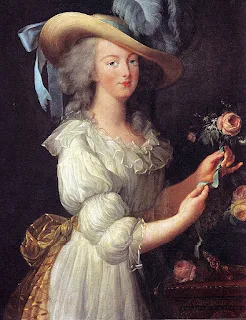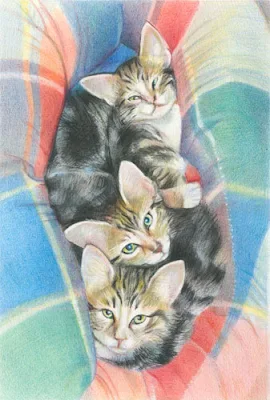The MAM Poll for March asked the question How do you price your art? It examined your preferences across a range of different approaches to pricing art and finished earlier today. The results have been counted - and the winner is..........a three way draw - more or less!
Set your prices and stick with them. The market looks for consistency in pricing from an artist.After an initial jockeying for position, the poll settled down into a pattern with two front runners virtually the same all the way through with a third close on their heels.
This month I've ranked the chart in order of popularity to make it easier to see the results. If you click on chart you can see a larger image. It has to be said that a number of people commented that they used a combination of approaches to arrive at a baseline which now guides their pricing. Others commented on how much prices varied depending on the medium you work in.
Popular options for pricing art
Of the 146 people who took part in the poll:
- 21% price their art on per square inch or square cm basis
- 20% have specific prices for specific sizes
- 18% base prices on comparable art for sale where you live
Price per square inch/cm (21%)
The artist determines a standard price per square inch or centimetre and applies this to all artwork. This can lead to some very odd prices unless a different standard price is used for very small or very large pieces.The advantage of the price per square inch approach is that it makes it very easy to price artwork (if you keep frames or any other additional costs consistent). It's certainly one I use as a check on prices I set for specific types and sizes of my art.
However it does tend to underprice small works and overprice large artwork. If you subscribe to the notion that price should be determined by both skills (the fixed cost) and the variable costs of the size of the canvas or paper covered (the variable cost) - as well as what the market will bear. Otherwise it's becomes a bit like pricing for painting a room!
The other problem is that it can result in some rather odd prices which people generally end up rounding to the nearest $10/£5
A number of artists commented that size was immaterial - and that in fact it was more difficult and took longer to produce quality artwork in small sizes!
Specific prices for specific sizes (20%)
This is a variation of the price per square inch which adjusts (rounds) the price to a value which sounds more like a reasonable price. It avoids odd sounding prices.This, if you like, is the cleaned up and harmonised version of price per square inch/cm! You'll rarely find prices which are odd sums with this approach.
Casey Klahn suggested that it was very important to compute your "most sales" price point. The notion being that this provides a guideline for how you divide your time between pieces of different sizes. The more pieces you produce in the size and price range that has a good track record for sales, the more likely you are to achieve actual sales in reality.
Based on comparable art where I live (18%)
The artist studies prices displayed in local galleries and other places where art is sold and finds a comparable artist in terms of media and/or subject matter and relates prices to these. Success with this strategy depends on whether or not the baseline artist is selling work and how much a reputation earned over years has been factored into the price they charge.This proved to be much more popular than I was expecting given that the poll was being taken by an online audience. I guess it's because many people seek to sell their art locally as well as online and consequently MUST be aware of what sort prices are being achieved for artwork in local galleries and other place selling artwork.
It's also worth bearing in mind that irrespective of where you live buyers often check out an artists prices online and they're certainly not going to be buying in galleries if they find the same or similar work online for a different (lower) price.
Alternative approaches
The three options in the middle of the pack are based on gut feel - and some research.
Plucked from the air (10%)
This is the "it feels like a $500 painting to me" approach. There is no obvious rationale other than a gut feel and/or a wish to avoid doing research to check out the current state of the marketplaceI've used this one before now and my guess is most people probably have at one time or another. But it's difficult to use this approach over time to provide a consistent basis for pricing artwork. It's also difficult to escape the fact that sooner or later we all need to do some research!
This approach works better the more you look at art and build a knowledge about how other artists are pricing their art within different marketplaces, galleries and other places for selling art. I cannot recommend too highly that you go and see exhibitions and collect exhibition catalogues!
I always go round exhibitions making notes about which works are selling and what seems to be the upper and lower limits of the range of sales - which are obviously different for different sizes and artists. I often find myself looking back at catalogues from the exhibition last year! (Which is not to say that I always agree with prices people put on their work. What I judge to be overpriced work gets a great big exclamation mark on the catalogue from me!)
Based on comparable art on the Internet (9%)
The artist looks at what else is available on the Internet and picks an artist or group of artists, notes the prices asked (or achieved at auction) and then adjusts accordingly. More astute artists search for information about the price asked which actually achieves a sale.Just as locality played a more important role, it appears rather fewer artists than I expected base their prices on comparable online artwork. Or maybe they don't feel they have the time to do the research - or just don't understand some of the pricing decisions used by some artists who sell artwork on the Internet. I know I certainly come into the latter category now and again. I'm amazed at the number of people - with extremely variable talents - who think that the price of a daily painting is $100!
Cost plus (wage rate+materials cost+markup) (8%)
The artist determines an hourly rate for their work, adds in the cost of materials (and matting and framing if applicable) and then adds a flat rate or a percentage as a mark-up which covers marketing and other business expenses and/or a profit element.Sounds complicated doesn't it? However it's certainly an approach which is worth using 'backwards' as it were to see how much you're paying yourself as a wage for your work. I'll do a post later this week showing you how to do this.
Least popular approaches to pricing art?
The options with the fewest votes might be deemed least popular. But are they?
No. of hours spent on the artwork (6.2%)
The price is determined by a calculated hourly rate based on the notion that materials costs are incidental and the crucial cost driver is the number of hours required to complete the work. It bears no relation whatsoever to whether or not the market will pay the price.This approach had very few supporters. I'm wondering if this is because it has to prove itself as a successful approach in terms of generating sales for it to be adopted in the longer term. I'm guessing this is an approach which gets tried and abandoned by quite a few artists.
One of the things I observe talking with artists is how many of the more astute ones work out ways to speed up their art-making as they begin to realise that time has an opportunity cost - and is one of the key variables which you have a lot of control when it comes to earning money. What do you spend your time on?
Many start to adopt approaches which might reek of 'the conveyor belt' to some whereas they are in fact quite straightforward and sensible approaches to being efficient in the use of time. Such approaches can be quite simple things like gessoing 20 boards of a standard size in one go. Or even better getting the spouse, partner or responsible child to do it for you!
Artists did confess to feeling guilty for charging high prices - and getting sales - for artwork which didn't take long to do. To which my response is to ask how long have you spent working at your art so that you can work quickly and with skill?
Percentage increase each year (2.7%)
This approach is often used by an emerging artist who wants to grow sales income over time. The emphasis is always on relating to prices charged in previous years rather than what the market will bear or is currently paying for comparable work or input costs.This was the least popular option - but that might be because if was seen as a refinement of one of the others which formed the basic approach.
It occurs to me that those people who voted for this option might well also include people who have already set prices according to 'specific prices for specific sizes'. These are typically not emerging artists but rather those who have got several years experience who have worked out which price bracket their art sells in and only need to adjust for inflation
I guess the question is will artists adopting this approach also need to adjust for deflation in the future?
Other options identified by respondents
Artists participating in the survey also identified other ways of pricing art. These included:
- Gallery guides on/decides pricing policy for an artist's work
- If the artist likes a piece a lot then it has to have a high enough price which would make a sale worthwhile!
My blog post Guidance on pricing art last week attracted a large number of comments which are summarised below.
- In general people thought that it was very helpful if competition/exhibition organisers provided price guidelines to exhibiting artists re. different types or sizes of artwork. While some provide a minimum price guide maybe there also needs to be a maximum price guide as well - unless agreed otherwise with individual artists?
- People were generally averse to the notion that organisers or gallery owners could reduce prices without consultation with or the agreement of the artist
- Some artists were VERY concerned about the idea that the exhibition people could devalue their other sales if they dropped the price too much. Hence the need to be clear about the scope for and limitations on wiggle room granted to the exhibition organisers.
- In general people would not be averse to signing a contract which gave the sales people some wiggle room on pricing and discounts - but only if this was clearly specified in any contract and so long as it was not exceeded beyond what was agreed.
If it's well priced it's seen at as cheap, if it's cheap, then it's not good and if it's not good then it's not worth having.























